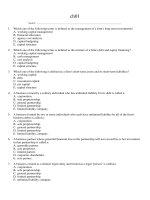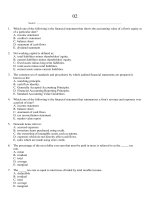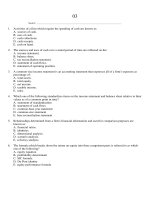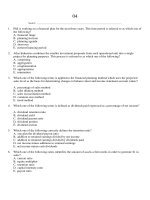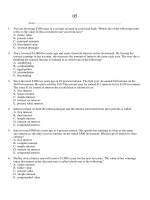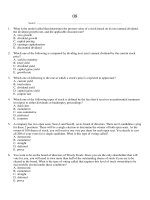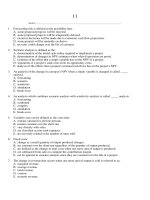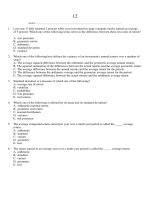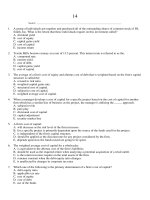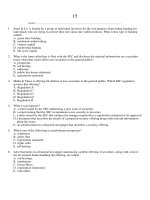Chapter 18 fundamentals of corporate finance 9th edition test bank
Bạn đang xem bản rút gọn của tài liệu. Xem và tải ngay bản đầy đủ của tài liệu tại đây (312.3 KB, 26 trang )
18
Student: ___________________________________________________________________________
1.
The length of time between the purchase of inventory and the receipt of cash from the sale of that
inventory is called the:
A. operating cycle.
B. inventory period.
C. accounts receivable period.
D. accounts payable period.
E. cash cycle.
2.
The length of time that elapses between the day a firm purchases an inventory item and the day that item
sells is called the:
A. operating cycle.
B. inventory period.
C. accounts receivable period.
D. accounts payable period.
E. cash cycle.
3.
The length of time between the sale of inventory and the collection of the payment for that sale is called
the:
A. operating cycle.
B. inventory period.
C. accounts receivable period.
D. accounts payable period.
E. cash cycle.
4.
The length of time between the day a firm purchases an item from its supplier until the day that supplier
is paid for that purchase is called the:
A. operating cycle.
B. inventory period.
C. accounts receivable period.
D. accounts payable period.
E. cash cycle.
5.
Central Supply purchased a toboggan for inventory this morning and paid cash for it. The time period
between today and the day Central Supply will receive cash from the sale of this toboggan is called
the:
A. operating cycle.
B. inventory period.
C. accounts receivable period.
D. accounts payable period.
E. cash cycle.
6.
A graphical representation of the operating and cash cycles is called a(n):
A. operating chart.
B. cash flow time line.
C. production flow line.
D. component chart.
E. working time line.
7.
Costs that increase as a firm acquires additional current assets are called _____ costs.
A. carrying
B. shortage
C. order
D. safety
E. trading
8.
Costs that decrease as a firm acquires additional current assets are called _____ costs.
A. carrying
B. shortage
C. debt
D. equity
E. payables
9.
Steve has estimated the cash inflows and outflows for his hardware store for next year. The report that he
has prepared recapping these cash flows is called a:
A. pro forma income statement.
B. sales projection.
C. cash budget.
D. receivables analysis.
E. credit analysis.
10. Taylor Supply has made an agreement with its bank that it can borrow up to $10,000 at any time over the
next year. This arrangement is called a(n):
A. floor loan.
B. open loan.
C. compensating balance.
D. line of credit.
E. bank note.
11. Money deposited by a borrower with the bank in a low or non-interest-bearing account as a condition of a
loan agreement is called a:
A. compensating balance.
B. secured credit deposit.
C. letter of credit.
D. line of credit.
E. pledge.
12. Brustle's Pottery either factors or assigns all of its receivables to other firms. This is known as:
A. accounts receivable financing.
B. pledged financing.
C. capital funding.
D. daily funding.
E. capital financing.
13. Rose's Gift Shop borrows money on a short-term basis by pledging its inventory as collateral. This is an
example of a(n):
A. debenture.
B. line of credit.
C. banker's acceptance.
D. working loan.
E. inventory loan.
14. Which one of the following increases cash?
A. granting credit to a customer
B. purchasing new machinery
C. making a payment on a bank loan
D. purchasing inventory
E. accepting credit from a supplier
15. Which of the following are uses of cash?
I. collecting a receivable
II. increasing inventory
III. obtaining a bank loan
IV. paying a supplier for previous purchases
A. I and III only
B. II and IV only
C. I and II only
D. I, II, and IV only
E. II, III, and IV only
16. Which one of the following will increase net working capital? Assume the current ratio is greater than
1.0.
A. paying a supplier for a previous purchase
B. paying off a long-term debt
C. selling inventory at cost
D. purchasing inventory on credit
E. selling inventory at a profit on credit
17. Which one of the following will decrease the net working capital of a firm? Assume the current ratio is
greater than 1.0.
A. selling inventory at cost
B. collecting payment from a customer
C. paying a payment on a long-term debt
D. selling a fixed asset for book value
E. paying a supplier for the purchase of an inventory item
18. Which of the following are sources of cash?
I. decrease in inventory
II. increase in accounts receivable
III. repayment of a bond
IV. sale of preferred stock
A. I and III only
B. I and IV only
C. II and III only
D. I, II, and III only
E. I, III, and IV only
19. Which of the following will increase the operating cycle?
I. increasing the inventory turnover rate
II. increasing the payables period
III. decreasing the receivable turnover rate
IV. decreasing the inventory level
A. I only
B. III only
C. II and IV only
D. I and IV only
E. II and III only
20. Which one of the following equals the operating cycle?
A. cash cycle plus accounts receivable period
B. inventory period plus the accounts receivable period
C. inventory period plus the accounts payable period
D. accounts payable period minus the cash cycle
E. accounts payable period plus the accounts receivable period
21. Which one of the following will decrease the operating cycle?
A. decreasing the inventory turnover rate
B. decreasing the accounts payable period
C. increasing the accounts receivable turnover rate
D. increasing the accounts payable period
E. increasing the accounts receivable period
22. The operating cycle describes how a product:
A. is priced.
B. is sold.
C. moves through the current asset accounts.
D. moves through the production process.
E. generates a profit.
23. Which of the following determines the length of the operating cycle?
I. cash cycle
II. inventory period
III. accounts payable period
IV. accounts receivable period
A. I and III only
B. II and IV only
C. I, II, and IV only
D. II, III, and IV only
E. I, II, III, and IV
24. Which of the following will increase the cash cycle, all else constant?
I. increasing the inventory period
II. decreasing the accounts receivable turnover rate
III. increasing the accounts payable period
IV. decreasing the accounts receivable period
A. I and II only
B. III and IV only
C. I and IV only
D. I, II, and III only
E. I, III, and IV only
25. An increase in which one of the following will decrease the cash cycle, all else equal?
A. payables turnover
B. days sales in inventory
C. operating cycle
D. inventory turnover rate
E. accounts receivable period
26. Metal Designs, Inc., historically produced products for inventory. Now, the firm only produces a product
when it receives an actual order from a customer. All else equal, this change will:
A. increase the operating cycle.
B. lengthen the accounts receivable period.
C. shorten the accounts payable period.
D. decrease the cash cycle.
E. decrease the inventory turnover rate.
27. Which of the following statements are correct?
I. An increase in the accounts payable period shortens the cash cycle.
II. The cash cycle is equal to the operating cycle minus the inventory period.
III. A negative cash cycle is preferable to a positive cash cycle.
IV. The cash cycle plus the accounts receivable period is equal to the operating cycle.
A. I only
B. III and IV only
C. I and III only
D. I and IV only
E. I, II, and III only
28. Which one of the following statements is correct concerning the cash cycle?
A. The longer the cash cycle, the more likely a firm will need external financing.
B. Increasing the accounts payable period increases the cash cycle.
C. A positive cash cycle is preferable to a negative cash cycle.
D. The cash cycle can exceed the operating cycle if the payables period is equal to zero.
E. Offering early payment discounts to customers will tend to increase the cash cycle.
29. Which of the following actions will tend to decrease the inventory period?
I. discontinuing all slow-selling merchandise
II. selling obsolete inventory below cost just to get rid of it
III. buying raw materials only as needed for the manufacturing process
IV. producing goods on demand versus for inventory
A. I and III only
B. II and IV only
C. II, III, and IV only
D. I, II, and III only
E. I, II, III, and IV
30. Which one of the following actions will tend to increase the accounts receivable period? Assume the
accounts receivable period is currently 34 days.
A. tightening the standards for granting credit to customers
B. refusing to grant additional credit to any customer who pays late
C. increasing the finance charges applied to all customer balances outstanding over thirty days
D. granting discounts for cash sales
E. eliminating the discount for early payment by credit customers
31. An increase in which one of the following is an indicator that an accounts receivable policy is becoming
more restrictive?
A. bad debts
B. accounts receivable turnover rate
C. accounts receivable period
D. credit sales
E. operating cycle
32. If you pay your suppliers five days sooner, then:
A. your payables turnover rate will decrease.
B. you may require additional funds from other sources to fund the cash cycle.
C. the cash cycle will decrease.
D. your operating cycle will increase.
E. the accounts receivable period will decrease.
33. Which one of the following will increase the accounts payable period, all else constant?
A. an increase in the cost of goods sold account value
B. an increase in the ending accounts payable balance
C. an increase in the cash cycle
D. a decrease in the operating cycle
E. an increase in the accounts payable turnover rate
34. Which one of the following managers determines which customers must pay cash and which can charge
their purchases?
A. purchasing manager
B. credit manager
C. controller
D. production manager
E. payables manager
35. Which one of the following managers determines when a supplier will be paid?
A. controller
B. payables manager
C. credit manager
D. purchasing manager
E. production manager
36. A firm with a flexible short-term financial policy will:
A. maintain a low balance in accounts receivables.
B. only have minimal amounts, if any, invested in marketable securities.
C. invest heavily in inventory.
D. have low cash balances.
E. have tight restrictions on granting credit to customers.
37. Which one of the following is indicative of a short-term restrictive financial policy?
A. purchasing inventory on an as-needed basis
B. granting credit to all customers
C. investing heavily in marketable securities
D. maintaining a large accounts receivable balance
E. keeping inventory levels high
38. Which of the following are associated with a restrictive short-term financial policy?
I. little, if any, investment in marketable securities
II. liberal credit terms for customers
III. low cash balances
IV. increasing inventory levels
A. I and III only
B. II and IV only
C. I and IV only
D. III and IV only
E. I, II, and III only
39. The Lumber Mart recently replaced its management team. As a result, the firm is implementing a
restrictive short-term policy in place of the flexible policy under which the firm had been operating.
Which of the following should the employees expect as a result of this policy change?
I. reduction in sales due to stock outs
II. greater inventory selection
III. decreased sales due to the new accounts receivable credit policy
IV. decreased investment in marketable securities
A. I and II only
B. II and IV only
C. I, II, and IV only
D. I, III, and IV only
E. I, II, III, and IV
40. A flexible short-term financial policy:
A. increases a firm's need for long-term financing.
B. minimizes net working capital.
C. avoids bad debts by only selling items for cash.
D. maximizes fixed assets and minimizes current assets.
E. is most appropriate for a firm with relatively high carrying costs and relatively low shortage costs.
41. A flexible short-term financial policy:
I. increases shortage costs due to frequent cash-outs.
II. tends to increase sales as compared to a restrictive policy.
III. requires a sizeable investment in current assets.
IV. incurs more carrying costs than a restrictive policy.
A. I and IV only
B. II and III only
C. I, II, and III only
D. II, III, and IV only
E. I, III, and IV only
42. Shortage costs include which of the following?
I. disruption of production schedules
II. inventory ordering costs
III. lost customer goodwill
IV. brokerage costs
A. I and II only
B. II and III only
C. II, III, and IV only
D. I, II, and III only
E. I, II, III, and IV
43. The optimal investment in current assets for an operating firm occurs at the point where:
A. both shortage costs and carrying costs equal zero.
B. shortage costs are equal to zero.
C. carrying costs are equal to zero.
D. carrying costs exceed shortage costs.
E. the total costs of holding current assets is minimized.
44. Which one of the following statements is correct?
A. A firm with a restrictive financing policy secures sufficient long-term financing to fund all its assets.
B. A firm with a flexible financing policy frequently invests in marketable securities.
C. A firm with a flexible financing policy tends to use short-term financing on a frequent basis.
D. Firms tend to avoid short-term financing under both restrictive and flexible financing policies.
E. Firms with seasonal sales select flexible financing policies.
45. Which one of the following statements is correct?
A. Seasonal needs are financed externally when firms adhere to a flexible financing policy.
B. A flexible financing policy tends to increase the risk of encountering financial distress.
C. Long-term interest rates tend to be less volatile than short-term rates.
D. Most firms tend to finance inventory with long-term debt.
E. Short-term interest rates are generally higher than long-term rates.
46. Assume each month has 30 days and a firm has a 60-day accounts receivable period. During the second
calendar quarter of the year, that firm will collect payment for the sales it made during which of the
following months?
A. October, November, and December
B. November, December, and January
C. December, January, and February
D. January, February, and March
E. February, March, and April
47. The Harvester collects 25 percent of sales in the month of sale, 60 percent of sales in the month following
the month of sale, and 15 percent of sales in the second month following the month of sale. During the
month of April, the firm will collect:
A. 60 percent of February sales.
B. 15 percent of April sales.
C. 60 percent of March sales.
D. 15 percent of March sales.
E. 25 percent of February sales.
48. A manufacturing firm has a 90 day collection period. The firm produces seasonal merchandise and
thus has the least sales during the first quarter of a year and the highest level of sales during the fourth
quarter of a year. The firm maintains a relatively steady level of production which means that its cash
disbursements are fairly equal in all quarters. The firm is most apt to face a cash-out situation in:
A. the first quarter.
B. the second quarter.
C. the third quarter.
D. the fourth quarter.
E. any quarter with equal probabilities of occurrence.
49. Jill is the CFO of Summertime Adventures which is a seasonal firm specializing in products related to
water sports. The firm purchases inventory one month before it is sold and pays for its purchases 60
days after the invoice date. Sales are highest during July and August. Currently, Jill is preparing the cash
disbursements section of the firm's cash budget. Which one of the following statements is supported by
this information?
A. Inventory purchases will be highest during the months of July and August.
B. Inventory purchases will be highest during the months of May and June.
C. Payments to suppliers will be highest during the months of June and July.
D. Payments to suppliers will be highest during the months of July and August.
E. Payments to suppliers will be highest during the months of August and September.
50. Which two of the following are most apt to cause a cash-out for a firm that is generally financially sound?
I. fixed expenses
II. fixed asset purchases
III. flexible financing policy
IV. highly seasonal sales
A. I and III only
B. II and IV only
C. III and IV only
D. I, II, and III only
E. II, III, and IV only
51. Which one of the following statements is correct concerning the cash balance of a firm?
A. Most firms attempt to maintain a zero cash balance at all times.
B.The cumulative cash surplus shown on a cash budget is equal to the ending cash balance plus the
minimum desired cash balance.
C. On a cash balance report, the cumulative cash surplus at the end of May is used as June's beginning
cash balance.
D. A cumulative cash deficit indicates a borrowing need.
E. The ending cash balance must equal the minimum desired cash balance.
52. A cumulative cash deficit indicates a firm:
A. has at least a short-term need for external funding.
B. is facing long-term financial distress.
C. will go out of business within the year.
D. is capable of funding all of its needs internally.
E. is using its cash wisely.
53. The most common means of financing a temporary cash deficit is a:
A. long-term secured bank loan.
B. short-term secured bank loan.
C. short-term issue of corporate bonds.
D. long-term unsecured bank loan.
E. short-term unsecured bank loan.
54. The primary difference between a line of credit and a revolving credit arrangement is the:
A. type of collateral used to secure the loan.
B. length of the credit period.
C. fact that the line of credit is a secured loan and the revolving credit arrangement is unsecured.
D. fact that the line of credit is an unsecured loan and the revolving credit arrangement is secured.
E. classification as either a committed or a noncommitted loan.
55. A compensating balance:
I. is required when a firm acquires any bank financing other than a line of credit.
II. increases the cost of short-term bank financing.
III. may be required even if a firm never borrows funds.
IV. is often used as a means of paying for banking services received.
A. I and III only
B. II and IV only
C. II and III only
D. I and IV only
E. II, III, and IV only
56. High Point Hotel (HPH) has $165,000 in accounts receivable. To finance a major purchase, the company
assigns these receivables to Cross Town Bank. Which one of the following statements correctly describes
this transaction?
A. HPH will immediately receive $165,000 and will have no further obligation related to these
receivables.
B. HPH will receive some amount of cash immediately while maintaining full responsibility for any
uncollected receivables.
C Cross Town Bank accepts full responsibility for the collection of the accounts receivables and, in
. exchange, immediately pays HPH a discounted value for its receivables.
DCross Town Bank accepts full responsibility for collecting the accounts receivables and pays HPH a
. discounted price for the accounts collected after the normal collection period has elapsed.
E.HPH receives the full amount of its receivables upon assignment but must reimburse Cross Town Bank
for any uncollected account.
57. Which one of the following statements is correct?
A. The assignment of receivables involves selling the firm's accounts receivables at full price.
B. Lines of credit frequently require a cleanup period.
C. With maturity factoring, the borrower receives the loan amount immediately.
D. Commercial paper is short-term financing offered to highly-rated corporations by major banks.
E. Credit card receivables funding is a relatively inexpensive method of borrowing on a short-term basis.
58. Which of the following are benefits derived from short-term financial planning?
I. having advance notice of when your firm will require external financing
II. being able to determine the extent of time for which a loan is required
III. having the ability to time capital expenditures in order to place the least financial burden possible on a
firm
IV. knowing for certain what your cash balance will be six months in advance
A. I and III only
B. I, II, and III only
C. II, III, and IV only
D. I, II, and IV only
E. I, II, III, and IV
59. Denver Interiors, Inc., has sales of $836,000 and cost of goods sold of $601,000. The firm had a
beginning inventory of $41,000 and an ending inventory of $47,000. What is the length of the inventory
period?
A. 19.21 days
B. 20.89 days
C. 26.72 days
D. 30.53 days
E. 33.69 days
60. A national firm has sales of $729,000 and cost of goods sold of $478,000. At the beginning of the year,
the inventory was $37,000. At the end of the year, the inventory balance was $41,000. What is the
inventory turnover rate?
A. 12.26 times
B. 12.78 times
C. 14.22 times
D. 18.56 times
E. 19.70 times
61. North Side Wholesalers has sales of $948,000. The cost of goods sold is equal to 72 percent of sales.
The firm has an average inventory of $23,000. How many days on average does it take the firm to sell its
inventory?
A. 11.24 days
B. 12.30 days
C. 16.48 days
D. 26.35 days
E. 29.68 days
62. The Bear Rug has sales of $811,000. The cost of goods sold is equal to 63 percent of sales. The beginning
accounts receivable balance is $41,000 and the ending accounts receivable balance is $38,000. How long
on average does it take the firm to collect its receivables?
A. 17.26 days
B. 17.78 days
C. 18.58 days
D. 20.44 days
E. 29.77 days
63. The Blue Star has sales of $387,000, costs of goods sold of $259,000, average accounts receivable of
$9,800, and average accounts payable of $12,600. How long does it take for the firm's credit customers to
pay for their purchases?
A. 7.67 days
B. 8.78 days
C. 9.24 days
D. 11.88 days
E. 13.81 days
64. The Mountain Top Shoppe has sales of $512,000, average accounts receivable of $31,400 and average
accounts payable of $24,800. The cost of goods sold is equivalent to 71 percent of sales. How long does it
take The Mountain Top Shoppe to pay its suppliers?
A. 21.76 days
B. 22.38 days
C. 24.90 days
D. 25.89 days
E. 26.67 days
65. HG Livery Supply had a beginning accounts payable balance of $57,300 and an ending accounts payable
balance of $55,100. Sales for the period were $610,000 and costs of goods sold were $442,000. What is
the payables turnover rate?
A. 7.86 times
B. 8.39 times
C. 9.02 times
D. 9.86 times
E. 10.85 times
66. Your firm has an inventory turnover rate of 14, a payables turnover rate of 8, and a receivables turnover
rate of 19. How long is your firm's operating cycle?
A. 45.06 days
B. 45.28 days
C. 45.63 days
D. 53.13 days
E. 53.78 days
67. Merryl Enterprises currently has an operating cycle of 62 days. The firm is analyzing some operational
changes, which are expected to increase the accounts receivable period by 2 days and decrease the
inventory period by 5 days. The accounts payable turnover rate is expected to increase from 42 to 46
times per year. If all of these changes are adopted, what will the firm's new operating cycle be?
A. 51 days
B. 57 days
C. 59 days
D. 60 days
E. 65 days
68. On average, Furniture & More is able to sell its inventory in 27 days. The firm takes 87 days on average
to pay for its purchases. On the other hand, its average customer pays with a credit card which allows the
firm to collect its receivables in 4 days. Given this information, what is the length of operating cycle?
A. 31 days
B. 38 days
C. 45 days
D. 56 days
E. 62 days
69. Interior Designs has an inventory period of 46 days, an accounts payable period of 38 days, and an
accounts receivable period of 32 days. Management is considering an offer from their suppliers to pay
within 10 days and receive a 2 percent discount. If the new discount is taken, the accounts payable
period is expected to decline by 26 days. If the new discount is taken, the operating cycle will be _____
days.
A. 52
B. 62
C. 71
D. 78
E. 91
70. Metal Products Co. has an inventory period of 53 days, an accounts payable period of 68 days, and an
accounts receivable turnover rate of 18. What is the length of the cash cycle?
A. 3.00 days
B. 5.28 days
C. 26.28 days
D. 71.00 days
E. 73.28 days
71. West Chester Automation has an inventory turnover of 16 and an accounts payable turnover of 11. The
accounts receivable period is 36 days. What is the length of the cash cycle?
A. 5.67 days
B. 25.63 days
C. 41.00 days
D. 52.00 days
E. 58.81 days
72. Peterson's Antiquities currently has a 31 day cash cycle. Assume the firm changes its operations such that
it decreases its receivables period by 2 days, decreases its inventory period by 3 days, and decreases its
payables period by 4 days. What will the length of the cash cycle be after these changes?
A. 22 days
B. 23 days
C. 29 days
D. 30 days
E. 31 days
73. A company currently has a 48 day cash cycle. Assume the firm changes its operations such that it
decreases its receivables period by 2 days, increases its inventory period by 3 days, and increases its
payables period by 4 days. What will the length of the cash cycle be after these changes?
A. 42 days
B. 43 days
C. 45 days
D. 47 days
E. 49 days
74. Tall Guys Clothing has a 45 day collection period. Sales for the next calendar year are estimated at
$2,100, $1,600, $2,500 and $2,300, respectively, by quarter, starting with the first quarter of the year.
Given this information, which one of the following statements is correct? Assume a year has 360
days.
A. The firm will collect $800 in Quarter 2.
B. The accounts receivable balance at the beginning of Quarter 4 will be $1,150.
C. The firm will collect $2,000 in Quarter 3.
D. The firm will have an accounts receivable balance of $2,300 at the end of the year.
E. The firm will collect a total of $2,400 in Quarter 4.
75. Forest Gardens, Inc., has a beginning receivables balance on February 1 of $730. Sales for February
through May are $720, $760, $820, and $850, respectively. The accounts receivable period is 30 days.
What is the amount of the April collections? Assume a year has 360 days.
A. $720
B. $760
C. $790
D. $820
E. $850
76. Davis and Davis have expected sales of $490, $465, $450, and $570 for the months of January through
April, respectively. The accounts receivable period is 28 days. What is the accounts receivable balance at
the end of March? Assume a year has 360 days.
A. $420
B. $426
C. $440
D. $450
E. $482
77. The Athletic Sports Store has a beginning receivables balance on January 1 of $410. Sales for January
through April are $440, $460, $690, and $720, respectively. The accounts receivable period is 60 days.
How much did the firm collect in the month of April? Assume a year has 360 days.
A. $410
B. $440
C. $460
D. $690
E. $720
78. Breakwater Aquatics has a 45 day accounts receivable period. The estimated quarterly sales for this year,
starting with the first quarter, are $6,800, $7,100, $8,200, and $6,400, respectively. What is the accounts
receivable balance at the beginning of the third quarter? Assume a year has 360 days.
A. $3,400
B. $3,550
C. $6,950
D. $7,100
E. $7,650
79. The Dog House expects sales of $560, $650, $670, and $610 for the months of May through August,
respectively. The firm collects 20 percent of sales in the month of sale, 70 percent in the month following
the month of sale, and 8 percent in the second month following the month of sale. The remaining 2
percent of sales is never collected. How much money does the firm expect to collect in the month of
August?
A. $621
B. $628
C. $633
D. $639
E. $643
80. The Wire House purchases its inventory one quarter prior to the quarter of sale. The purchase price is 55
percent of the sales price. The accounts payable period is 45 days. The accounts payable balance at the
beginning of quarter one is $62,000. What is the amount of the expected disbursements for quarter two
given the following expected quarterly sales?
A. $20,500
B. $21,725
C. $24,250
D. $26,000
E. $26,675
81. Nadine's Boutique has a 30 day accounts payable period. The firm has expected quarterly sales of $1,100,
$1,400, $1,700, and $2,100, respectively, for next year. The quarterly cost of goods sold is equal to 68
percent of the next quarter's sales. The firm has a beginning accounts payable balance of $550 as of
Quarter 1. What is the amount of the projected cash disbursements for accounts payable for Quarter 3 of
the next year? Assume a year has 360 days.
A. $1,195
B. $1,208
C. $1,247
D. $1,337
E. $1,380
82. Kid's Delight expects to sell $8,200 worth of toys in December, $3,700 worth in January, $4,400 in
February, and $6,100 in March. The wholesale cost is 72 percent of the retail price. The firm has a
receivables period of 30 days, a payables period of 60 days, and buys inventory one month prior to selling
it. Which one of the following statements is correct?
A. The February payments to suppliers are $2,992.
B. The March collections are $3,700.
C. The accounts receivable balance at the end of March is $4,400.
D. The purchases for February are $3,168.
E. The accounts payable balance at the end of January is $5,832.
83. As of the beginning of the quarter, Swenson's, Inc. had a cash balance of $460. During the quarter, the
company collected $520 from customers and paid suppliers $360. The company also paid an interest
payment of $20 and a tax payment of $110. In addition, the company repaid $140 on its long-term debt.
What is Callahan's cash balance at the end of the quarter?
A. -$110
B. $320
C. $350
D. $430
E. $490
84. On May 1, your firm had a beginning cash balance of $175. Your sales for April were $430 and your
May sales were $480. During May, you had cash expenses of $110 and payments on your accounts
payable of $290. Your accounts receivable period is 30 days. What is your firm's beginning cash balance
on June 1?
A. $145
B. $155
C. $205
D. $215
E. $265
85. The Mish Mash Store has a beginning cash balance of $440 on March 1. The firm has projected sales
of $610 in February, $680 in March, and $740 in April. The cost of goods sold is equal to 70 percent of
sales. Goods are purchased one month prior to the month of sale. The accounts payable period is 30 days
and the accounts receivable period is 10 days. The firm has monthly cash expenses of $160. What is the
projected ending cash balance at the end of March? Assume every month has 30 days.
A. $258
B. $461
C. $507
D. $567
E. $621
86. Fancy Footwear has a line of credit with a local bank in the amount of $80,000. The loan agreement calls
for interest of 7 percent with a compensating balance of 5 percent, which is based on the total amount
borrowed. The compensating balance will be deposited into an interest-free account. What is the effective
interest rate on the loan if the firm needs to borrow $75,000 for one year to cover operating expenses?
A. 7.37 percent
B. 7.43 percent
C. 7.56 percent
D. 8.17 percent
E. 8.33 percent
87. Juno Industrial Supply has a $150,000 line of credit with a 6.5 percent interest rate. The loan agreement
requires a 2 percent compensating balance, which is based on the total amount borrowed, and which will
be held in an interest-free account. What is the effective interest rate if the firm borrows $90,000 on the
line of credit for one year?
A. 6.42 percent
B. 6.47 percent
C. 6.50 percent
D. 6.58 percent
E. 6.63 percent
88. Rachel's has a $50,000 line of credit with Uptown Bank. The line of credit calls for an interest rate of 8
percent and a compensating balance of 4 percent. The compensating balance is based on the total amount
borrowed and will be held in an interest-free account. What is the effective annual interest rate if the firm
borrows $35,000 for one year?
A. 7.76 percent
B. 8.00 percent
C. 8.17 percent
D. 8.33 percent
E. 8.42 percent
89. The Delta Fish Hatchery factors its accounts receivables immediately at a 1.5 percent discount. The
average collection period is 34 days. Assume that all accounts are collected in full. What is the effective
annual interest rate on this arrangement?
A. 17.61 percent
B. 18.20 percent
C. 18.36 percent
D. 18.78 percent
E. 19.04 percent
90. New York Bank provides Food Canning, Inc. a $250,000 line of credit with an interest rate of 1.75
percent per quarter. The credit line also requires that 1 percent of the unused portion of the credit line
be deposited in a non-interest bearing account as a compensating balance. Food Canning, Inc.'s shortterm investments are paying 1.2 percent per quarter. What is the effective annual interest rate on this
arrangement if the line of credit goes unused all year? Assume any funds borrowed or invested use
compound interest.
A. 4.76 percent
B. 4.80 percent
C. 4.89 percent
D. 7.00 percent
E. 7.27 percent
91. The Sports Store has a $100,000 line of credit with City Bank. The loan agreement requires that 2 percent
of the unused portion of the credit line be deposited in a non-interest bearing account as a compensating
balance. The interest rate on the borrowed funds is 1.4 percent per quarter. The Sport Store's short-term
investments are paying 1.5 percent per quarter. What is the effective annual interest rate on the line of
credit if The Sports Store borrows the entire $100,000 for one year? Assume any funds borrowed or
invested use compound interest.
A. 5.72 percent
B. 5.76 percent
C. 6.00 percent
D. 6.08 percent
E. 6.14 percent
92. Your bank offers you a $40,000 line of credit with an interest rate of 1.75 percent per quarter. The
loan agreement also requires that 2 percent of the unused portion of the credit line be deposited in a
non-interest bearing account as a compensating balance. Your short-term investments are paying 0.20
percent per month. What is your effective annual interest rate on this arrangement if you do not borrow
any money on this credit line during the year? Assume any funds borrowed or invested use compound
interest.
A. 2.00 percent
B. 2.43 percent
C. 3.18 percent
D. 7.00 percent
E. 7.19 percent
93. New Town Bank offers you a $40,000 line of credit with an interest rate of 1.85 percent per quarter. The
loan agreement also requires that 3 percent of the unused portion of the credit line be deposited in a noninterest bearing account as a compensating balance. Short-term investments are currently paying 1.1
percent per quarter. What is the effective annual interest rate on the line of credit if you borrow the entire
$40,000 for one year? Assume any funds borrowed or invested use compound interest.
A. 4.47 percent
B. 4.58 percent
C. 7.61 percent
D. 7.78 percent
E. 12.33 percent
94. Josie's Craft Shack has a beginning cash balance for the quarter of $1,126. The store has a policy of
maintaining a minimum cash balance of $1,000 and is willing to borrow funds as needed to maintain that
balance. Currently, the firm has a loan balance of $480. How much will the store borrow or repay if the
net cash flow for the quarter is -$280?
A. $0
B. $28
C. $126
D. $154
E. $280
95. The Cement Works has a beginning cash balance for the quarter of $784. Susie, the firm's president,
requires that a minimum cash balance of $800 be maintained and requires that borrowing be used to
maintain that balance. If funds have been borrowed, then she requires that those loans be repaid as soon
as excess funds are available. Currently, the firm has a loan outstanding of $1,260. How much will the
firm borrow or repay this quarter if the quarterly receipts are $3,918 and the quarterly disbursements are
$3,774?
A. borrow $16
B. borrow $128
C. borrow $144
D. repay $128
E. repay $144
96. At the beginning of the year, you have an outstanding short-term loan of $274 which was used to
cover your cash needs for the previous year. The interest expense for the year is $19. The projected net
cash flow for this year is $123, prior to any payment of principal or interest on this loan. What is your
anticipated loan balance at year end?
A. $151
B. $170
C. $176
D. $189
E. $193
97. List and describe the three basic types of secured inventory loans. Compare the advantages and
disadvantages of these loans.
98. Using two separate graphs, illustrate a flexible and a restrictive short-term financing policy. Place costs
on the vertical axis and current assets on the horizontal axis. On each graph, indicate the shortage costs,
carrying costs, total costs, and indicate the optimal investment in current assets.
99. Assume that long-term interest rates are substantially higher than short-term interest rates and are
expected to remain that way for the foreseeable future. How does this affect a firm's selection of a
financing policy for its current assets?
100.Compensating balances are frequently a part of revolving lending arrangements with banks, yet they add
to the cost of financing for the borrower. Why, then, would borrowers agree to such terms? What other
types of alternative financing are available?
101.Details Corp. has a book net worth of $8,150. Long-term debt is $1,650. Net working capital, other than
cash, is $2,150. Fixed assets are $2,000. How much cash does the company have?
A. $4,250
B. $4,550
C. $5,150
D. $5,650
E. $6,750
102.The Wake-Up Coffee Company has projected the following quarterly sales amounts for the coming year:
Accounts receivable at the beginning of the year are $200. Wake-Up has a 60-day collection period. What
is the amount of the accounts receivable balance at the end of Quarter 3?
A. $375
B. $450
C. $500
D. $600
E. $700
103.Consider the following financial statement information for the Bulldog Icers Corporation:
How long is the cash cycle?
A. 36.6 days
B. 37.2 days
C. 41.0 days
D. 41.4 days
E. 42.8 days
104.Your firm has an average collection period of 42 days. Current practice is to factor all receivables
immediately at a 4 percent discount. Assume that default is extremely unlikely. What is the effective cost
of borrowing?
A. 28.79 percent
B. 36.20 percent
C. 37.78 percent
D. 40.97 percent
E. 42.58 percent
105.Workout Together has projected the following sales for the coming year:
Sales in the year following this one are projected to be 18 percent greater in each quarter. Assume the
firm places orders during each quarter equal to 29 percent of projected sales for the next quarter. How
much will the firm pay to its suppliers in Quarter 2 if its accounts payable period is 60 days?
A. $212.67
B. $224.33
C. $241.67
D. $251.33
E. $256.67
106.The Thunder Dan's Corporation's purchases from suppliers in a quarter are equal to 65 percent of the
next quarter's forecasted sales. The payables period is 60 days. Wages, taxes, and other expenses are 16
percent of sales, and interest and dividends are $60 per quarter. No capital expenditures are planned.
Sales for the first quarter of the following year are projected at $720. The projected quarterly sales are:
What is the amount of the total disbursements for Quarter 2?
A. $564.27
B. $579.43
C. $582.15
D. $585.30
E. $590.67
107.The following is the sales budget for Duck-n-Run, Inc., for the first quarter of 2009:
The accounts receivable balance at the end of the previous quarter was $45,000 ($32,000 of which was
uncollected December sales.) What is the amount of the January collections?
A. $112,400.00
B. $112,408.16
C. $115,703.03
D. $122,356.33
E. $125,400.00
108.Here are some important figures from the budget of Nashville Nougats, Inc., for the second quarter of
2009:
The company predicts that 3 percent of its credit sales will never be collected, 36 percent of its sales will
be collected in the month of sale, and the remaining 61 percent will be collected in the following month.
Credit purchases will be paid in the month following the purchase.
In March 2009, credit sales were $302,400, and credit purchases were $224,640. The April 1 cash balance
was $403,200. What is the cash balance at the end of May?
A. $348,887
B. $366,846
C. $414,141
D. $457,777
E. $477,374
109.You've worked out a line of credit arrangement that allows you to borrow up to $50 million at any time.
The interest rate is 0.5 percent per month. In addition, 5 percent of the amount that you borrow must
be deposited in a non-interest bearing account. Assume your bank uses compound interest on its line of
credit loans. What is the effective annual interest rate on this lending arrangement?
A. 6.50 percent
B. 6.62 percent
C. 6.81 percent
D. 6.87 percent
E. 6.94 percent
110.A bank offers your firm a revolving credit arrangement for up to $115 million at an interest rate of 2
percent per quarter. The bank also requires you to maintain a compensating balance of 5 percent against
the unused portion of the credit line, to be deposited in a non-interest-bearing account. Assume you have
a short-term investment account at the bank that pays 1.3 percent per quarter, and assume the bank uses
compound interest on its revolving credit loans. What is the effective annual interest rate on the revolving
credit arrangement if your firm does not borrow any money during the year?
A. 0 percent
B. 5.0 percent
C. 5.2 percent
D. 5.3 percent
E. 5.5 percent
18 Key
1. A
2. B
3. C
4. D
5. E
6. B
7. A
8. B
9. C
10. D
11. A
12. A
13. E
14. E
15. B
16. E
17. C
18. B
19. B
20. B
21. C
22. C
23. B
24. A
25. D
26. D
27. C
28. A
29. E
30. E
31. B
32. B
33. B
34. B
35. B
36. C
37. A
38. A
39. D
40. A
41. D
42. E
43. E
44. B
45. C
46. E
47. C
48. B
49. E
50. B
51. D
52. A
53. E
54. B
55. E
56. B
57. B
58. B
59. C
60. A
61. B
62. B
63. C
64. C
65. A
66. B
67. C
68. A
69. D
70. B
71. B
72. D
73. C
74. E
75. B
76. A
77. C
78. B
79. E
80. B
81. D
82. E
83. C
84. C
85. B
86. A
87. E
88. D
89. A
90. C
91. A
92. B
93. C
94. D
95. D
96. B
Feedback: Refer to section 18.5
97. The three types are blanket lien, trust receipts, and field warehouse financing. The blanket lien is certainly the easiest for the firm since the
lender places a lien on the firm's entire inventory. Generally, the borrower does not have to provide any details on the inventory items. Trust
receipt financing requires the borrower and lender to specify the exact inventory item which secures each advance. This can be a time-consuming
and cumbersome type of financing for the firm. Field warehouse financing requires that an independent company supervise the collateral for the
lender. This, too, can be a cumbersome type of financing.
Feedback: Refer to section 18.3
98. Students should replicate graphs A and B in Figure 18.2 in the text.
Feedback: Refer to section 18.3
99. In this situation, firms will tend to prefer short-term debt over long-term debt and thus will tend to opt for a restrictive financing policy.
Feedback: Refer to section 18.4
100. Revolvers are flexible lending arrangements which make it convenient for firms to borrow funds on short notice for short periods of time.
This is particularly applicable to firms that adhere to a restrictive financing policy. Furthermore, since the compensating balance is typically
required only if the borrower draws on the line, the cost is incurred only while loans are outstanding. Alternative types of financing include letters
of credit, accounts receivable financing, inventory loans, commercial paper, and trade credit.
101. D
102. C
103. A
104. E
105. C
106. B
107. C
108. E
109. A
110. D
18 Summary
Category
AACSB: Analytic
AACSB: N/A
AACSB: Reflective thinking
Blooms: Analysis
Blooms: Application
Blooms: Comprehension
Blooms: Knowledge
Difficulty: Basic
Difficulty: Intermediate
EOC #: 18-10
EOC #: 18-11
EOC #: 18-13
EOC #: 18-14
EOC #: 18-2
EOC #: 18-5
EOC #: 18-6
EOC #: 18-7
EOC #: 18-8
EOC #: 18-9
Learning Objective: 18-1
Learning Objective: 18-2
Learning Objective: 18-3
Learning Objective: 18-4
Ross - Chapter 18
Section: 18.1
Section: 18.2
Section: 18.3
Section: 18.4
Section: 18.5
Section: 18.6
Topic: Accounts payable balance
Topic: Accounts payable period
Topic: Accounts payable turnover
Topic: Accounts receivable balance
Topic: Accounts receivable factoring
Topic: Accounts receivable financing
Topic: Accounts receivable period
Topic: Asset financing policies
Topic: Carrying costs
Topic: Cash balance
Topic: Cash budget
Topic: Cash collections
Topic: Cash cycle
Topic: Cash disbursements
Topic: Cash equation
Topic: Cash flow time line
Topic: Cash-out
Topic: Compensating balances
Topic: Cost of borrowing
Topic: Effective interest with compensating balance
Topic: Factoring receivables
Topic: Financing policies
Topic: Interest rate with compensating balance
# of Questions
48
58
4
10
40
25
35
99
11
1
1
1
1
1
1
1
1
1
1
39
14
52
5
110
6
39
15
25
21
4
1
4
1
3
1
1
5
1
1
5
2
8
11
3
1
1
1
2
2
1
1
3
2
